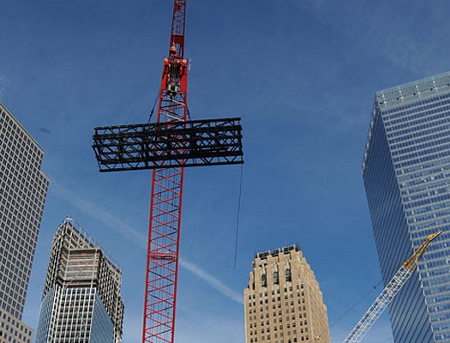Feature: Engineering Post-9/11
Remembering, Rebuilding, Renewing
Engineers have long been involved in helping the nation rise to challenges and recover from disaster, including the September 11 terrorist attacks.
To commemorate the tenth anniversary, eGFI has assembled features from ASEE’s PRISM magazine and other sources to illuminate engineering’s contributions to America’s post-9/11 efforts to rebuild, remember, and renew. From improving security to designing memorials and soaring new structures that soon will rise over the rubble at Ground Zero, engineers have played a major role.
Ground Zero Beacon
(PRISM, Sept. 2011)

Additional resources on One World Trade Center:
- The new One World Trade Center relies on century-old construction techniques. See the dramatic view from an upper beam in the New York Times Magazine (9/5) photo essay, “Ironworkers of the Sky.“
- The design and construction of the One World Trade Center and National Memorial and Museum is the subject of PBS’s NOVA tonight, “Engineering Ground Zero.” Also see NOVA’s short video, “Solving an Engineering Problem,” about developing a composting toilet, restaurant, and other amenities hundreds of feet up for construction workers on the scaffolding.
- See the construction’s progress on the NJ Port Authority’s live camera.
- ASEE’s PRISM magazine had Feb. 2005 feature on construction underway at One World Trade Center, “Rebuilding After 9/11.”
SEAT OF HONOR
 (From ASEE’s PRISM, Dec. 2008)
(From ASEE’s PRISM, Dec. 2008)
Rob Kelly says that when he first saw the design for a parklike memorial to the 184 victims of the 9/11 terrorist attack on the Pentagon, he was “stunned by the beauty” of the designers’ vision. The memorial consists of 184 stainless steel, cantilevered benches, each inscribed with a name. Designers came to Kelly, a professor of engineering and materials science at the University of Virginia, for help in selecting the right steel to use. They wanted something that would remain shiny and reflective for at least a century, and that was relatively inexpensive and strong enough to hold the weight of people sitting on it. “This was a classic engineering problem,” Kelly recalls, and he reviewed countless possibilities before choosing a steel that included small amounts of molybdenum and nitrogen, which help stave off corrosion. Kelly did the work pro bono. — Thomas K. Grose
Additional resources:
- The Smithsonian Institution’s American History Museum opened a temporary Remembrance and Reflections exhibit displaying 50 artifacts from the three sites of those fateful attacks.
- “What Price Security?” (PRISM, Sept. 2007) describes efforts to improve security and the impact of visa restrictions on engineering schools.
Filed under: Special Features
Tags: 9/11, Engineering, memorial, Pentagon memorial, September 11, World Trade Center









